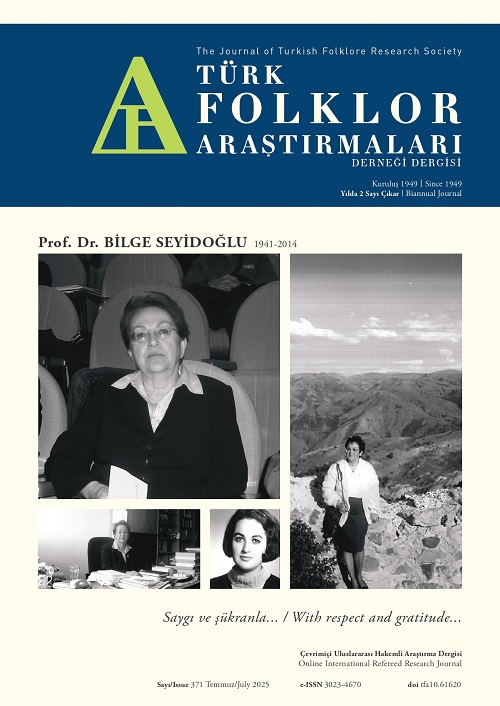Grimm Kardeşler Mirasını Edirne ve İstanbul Masalları Üzerinden Okuma Denemesi
Grimm Kardeşler
DOI:
https://doi.org/10.61620/tfa.75Anahtar Kelimeler:
Grimm mirası, masal, sözlü kültür, benzeşme, kültürel etkileşimÖzet
Masalın sözlü geleneğe ait bir tür olarak ele alınmasının ve türün ne olup ne olmadığına dair tartışmaların tarihi yaklaşık olarak 19. yüzyılın başlarına dayanmaktadır. Özellikle Alman Grimm Kardeşlerin, 1812-1822 yılları arasında yapmış oldukları derleme çalışmaları neticesinde ilk cildini 1812’de ikinci cildini de 1815'te yayımladıkları Alman halk masal külliyatı, yaygın bir kanaatle söz konusu tartışmalara milat kabul edilmektedir. Bununla beraber Grimm Kardeşlerin bu çalışması, Alman masallarının, dünyanın en meşhur masalları arasında sayılmasına da vesile olmuştur. Sözlü geleneğin en yaygın türlerinden biri olarak değerlendirilen masala dair tartışmaların, tarihsel açıdan başlangıcında pek çok noktaya dikkat çekildiği görülmektedir. Temelde masalı sözlü kültürün en bilindik ve sevilen formlarından biri olarak gören bu tartışmaların bir kısmı masalın tanımı, kökeni ya da kaynaklarına dair tespitleri içerirken bir kısmı da masal tasnifleri, masal tipleri ve masal motifleri üzerine odaklanmıştır. Söz konusu araştırmaların yaygınlaşması zamanla farklı kültürlerde mevcut olan masalların tür, tip ve motif bakımlarından karşılaştırmalı analizlerinin yapılabilmesine de imkân sağlamıştır. Buradan hareketle bu çalışmanın konusu olarak tüm dünyada yaygınlık ve bilinirlik konusunda en meşhur masal külliyatlarından biri olan Alman masalları ile özellikle Edirne (çeşitli zamanlarda Edirne’nin farklı bölgelerinden derlenmiş masallar) ve İstanbul masalları (Naki Tezel’in İstanbul Masalları adlı eserinden seçilen metinler) arasındaki ortak motifler ile kesit benzerliklerinin analizi hedeflenmiştir. Bu nedenle metin tarama ve zikredilen hususlar açısından tespit edilen metinler üzerinden mukayese yöntemi tercih edilmiştir. Bununla birlikte söz konusu çalışmada aslında sözlü gelenekten yazıya geçmiş olan masalların, yazılı kültür biçimlerinin de en az sözlü gelenekteki kadar etkili olabileceği iddiası, ilgili masalların tanıklığında tartışmaya açılmıştır.
Referanslar
Alangu, T. (2021). Türkiye folkloru el kitabı. YKY, İstanbul.
Burke, P. (1996), Yeniçağ başında Avrupa halk kültürü. ( çev. G. Aksan). İmge .Ankara.
Cocchiara, G. (2017), Avrupa’da folklor tarihi. Çev. Yerke Özer. Geleneksel. Ankara.
Çevik, M. (2008). Türkiye’de Batı masalları ve çocuklarımız. Gazi Türkiyat, Güz, S.1(3). Ankara.
Çobanoğlu, Ö. (2005). Halkbilimi kuramları ve araştırma yöntemleri tarihine giriş. Akçağ. Ankara.
Dégh, L. (1991). What did the Grimm Brothers give to and take from the folk? The Brothers Grimm and folktale. (Ed. James M. McGlathery). University of Illinois Press, Urbana and Chicago.
Dundes, A. (1998). Halk kimdir? Millî Folklor. (çev. M. Ekici). S.37, Bahar, s. 139-153.
Grimm, J. & Grimm, W. (2021). Grimm masalları. Cilt:1. (çev. K. Şipal). YKY, İstanbul.
Kılıç, V. G. (2020). Popüler masalların kullanım alanları: külkedisi masalı örneği. Global Media Journal TR Edition. 11 (21), Güz 2020. İstanbul.
Ong, W. (2013). Sözlü ve yazılı kültür- Sözün teknolojileşmesi. (çev. S. Postacıoğlu Banon). Metis. İstanbul.
Özünel, E. Ö. (2011). Yazının izinde masal haritalarını okuma denemesi: masal tarihine yeniden bakmak. Millî Folklor. Y.23, S. 91, 60-71.
Zipes, J. (2022). Grimmlerin mirası. (çev. N. Önoğlu). Alfa. İstanbul.
İndir
Yayınlanmış
Nasıl Atıf Yapılır
Sayı
Bölüm
Lisans
Telif Hakkı (c) 2025 Selma SOL

Bu çalışma Creative Commons Attribution 4.0 International License ile lisanslanmıştır.



